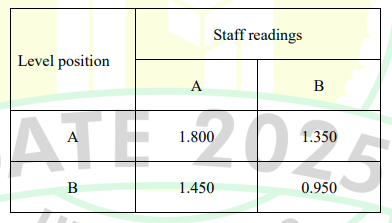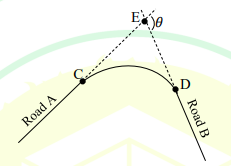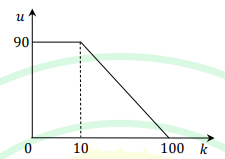Civil Engineering Gate Yearwise
Civil Gate 2025 Set-2
Civil Gate 2024 Set-1
Civil Gate 2024 Set-2
Civil Gate 2023 Set-1
Civil Gate 2023 Set-2
Civil Gate 2022 Set-1
Civil Gate 2022 Set-2
Civil Gate 2021 Set-1
Civil Gate 2021 Set-2
Civil Gate 2020 Set-1
Civil Gate 2020 Set-2
Civil Gate 2019 Set-1
Civil Gate 2019 Set-2
Civil Gate 2018 Set-1
Civil Gate 2018 Set-2
Civil Gate 2017 Set-1
Civil Gate 2017 Set-2
Civil Gate 2016 Set-1
Civil Gate 2016 Set-2
Civil Gate 2015 Set-1
Civil Gate 2015 Set-2
Civil Gate 2014 Set-1
Civil Gate 2014 Set-2
Civil Gate 2013
Civil Engineering GATE 2025 Set 1 Questions with Answer
Ques 53 Surveying
In levelling between two points A and B on the opposite banks of a river, the readings are taken by setting the instrument both at A and B, as shown in the table. If the RL of A is 150.000 m, the RL of B (in m) is ______ (rounded off to 3 decimal places).

Ques 54 Transportation Engineering
All the vehicles that come during a particular peak hour come during a 10-minute period within this hour. The 15-minute peak hour factor for this peak hour is
Ques 55 Transportation Engineering
In the context of testing bitumen, which one of the following statements is FALSE:
Ques 56 Transportation Engineering
The maximum degree of the curve that can be used for railways in a mountainous region is
Ques 57 Transportation Engineering
Road A and Road B are joined by a circular horizontal curve of radius 200 m as shown in the figure. Road A and Road B are tangential to the curve at the points C and D, respectively. Had the curve not been there, straight roads A and B would have met at the point E. The distance from C to E is 92 m. The value of angle θ (in degrees) is ______ (rounded off to 1 decimal place).
Note: The value of angle θ is to be calculated only from the consideration of Euclidean geometry and the data given in the problem.

Ques 58 Transportation Engineering
The speed-density relation on a one-way, single lane road is shown in the figure, where speed u is in km/hour and density k is in vehicles/km. The maximum flow (in vehicles/hour) on this road is

Ques 59 Transportation Engineering
A one-way, single lane road has traffic that consists of 30% trucks and 70% cars. The speed of trucks (in km/h) is a uniform random variable on the interval (30, 60), and the speed of cars (in km/h) is a uniform random variable on the interval (40, 80). The speed limit on the road is 50 km/h. The percentage of vehicles that exceed the speed limit is ______ (rounded off to 1 decimal place).
Note: X is a uniform random variable on the interval (α,β), if its probability density function is given by f(x)=1/(β-α), α
Ques 60 Transportation Engineering
During determination of the bulk specific gravity of compacted bituminous specimen, the mass in air of the specimen is 1260 g and volume is 525 cm3. The density of water is 1.0 g/cm3. The theoretical maximum specific gravity of mix is 2.510. The percentage air voids in the compacted specimen is ______ (rounded off to 2 decimal places).
Ques 61 Water Resources Engineering
To derive the total flood hydrograph at a catchment outlet from an isolated storm, the order in which the following methods are applied, from the first method to the last method, is
P. Obtaining the hyetograph
Q. Addition of baseflow
R. Estimation of initial and infiltration losses
S. Application of unit hydrograph
Ques 62 Water Resources Engineering
A water resources project with an expected life of 25 years has to be designed for an acceptable risk of 5% against a design flood. The return period for the design flood (in years) is ______ (rounded off to the nearest integer).
Ques 63 Water Resources Engineering
The mean rainfall over a catchment has to be estimated. The data for four rain gauges located in and around the catchment is listed in the table. Which one of the following statements is correct:
| Rain gauge station | P | Q | R | S |
| Whether located inside the catchment | Yes | No | Yes | Yes |
| Thiessen weightage factor | 0.10 | 0.50 | 0.25 | 0.15 |
| Rainfall (mm) | 110 | 100 | 100 | 125 |
Ques 64 Water Resources Engineering
Lacey's regime equations, followed in India for making scour calculations while designing hydraulic structures across alluvial channels, are given below. Regarding these equations, which of the following statements is/are true:
D=0.470×[Q/fs]1/3
P=4.75×√Q
fc=1.76×√d
where, Q is discharge and fs is silt factor.
Ques 65 Water Resources Engineering
A symmetrical trapezoidal canal is 100 km long. The bottom width is 10 m and the side slope is 1 Horizontal: 1 Vertical. The average flow depth in the canal is 2.5 m throughout the month of April. The measurement from a Class-A evaporimeter in the vicinity of the canal indicated an average evaporation rate of 0.5 cm/day in April.
The volume of water evaporated from the canal (in m3) in the month of April is ______ ×103 (rounded off to 1 decimal place).

Total Unique Visitors